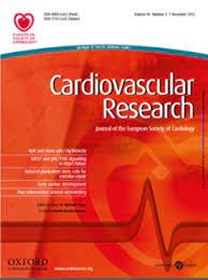花生四烯酸与阿司匹林协同作用,预防心肌缺血再灌注损伤,减轻出血风险
IF 10.2
1区 医学
Q1 CARDIAC & CARDIOVASCULAR SYSTEMS
引用次数: 0
摘要
目的心肌缺血再灌注(MI/R)损伤影响冠状动脉血运重建术的疗效。据报道,较高水平的循环花生四烯酸(AA)与较低的心血管疾病风险相关。环氧化酶(COX)途径将AA代谢为前列腺素(pg)和血小板活化血栓素A2 (TXA2),阿司匹林可抑制TXA2。我们的目的是探讨AA或其联合阿司匹林是否调节心肌梗死/再灌注损伤和阿司匹林引起的胃出血。方法和结果小鼠冠状动脉结扎30min后再灌注。AA可减轻小鼠心肌梗死/再灌注损伤,与阿司匹林联用可进一步提供心脏保护。阿司匹林抑制心肌/ r触发的血小板活化,在再灌注后立即改善微血管阻塞,而AA在再灌注后期改善微血管灌注,与冠状动脉舒张增加相一致。AA和阿司匹林联合用药可显著降低心脏中性粒细胞浸润和血管通透性,改善微循环。AA增加了尿液中PGI2和PGE2的代谢物,而不是TXA2,这种选择性的增强在与阿司匹林联合治疗时进一步增强。PGI2和PGE2的升高与梗死减少和心室功能改善相关,抑制COX-2可减弱协同心脏保护作用。此外,再灌注后口服AA和阿司匹林可提供最大程度的心脏保护,并消除阿司匹林引起的胃出血。结论AA与阿司匹林可协同预防心肌梗死/再灌注损伤,同时降低相关出血风险,是急性心肌梗死患者关注的重要问题。这可归因于PGI2和PGE2的选择性增强,而PGI2和PGE2被阿司匹林抑制TXA2放大,强调微循环改善和炎症改善。本文章由计算机程序翻译,如有差异,请以英文原文为准。
Arachidonic acid synergizes with aspirin preventing myocardial ischemia-reperfusion injury and mitigates bleeding risk
Aims The therapeutic efficacy of coronary revascularization is compromised by myocardial ischemia-reperfusion (MI/R) injury. Higher levels of circulating arachidonic acid (AA) are reportedly associated with lower risk of cardiovascular disease. The cyclooxygenase (COX) pathway metabolizes AA into prostaglandins (PGs) and the platelet-activating thromboxane A2 (TXA2), which is inhibited by aspirin. We aimed to explore whether AA or its combination with aspirin modulates MI/R injury and aspirin-caused gastric bleeding. Methods and results Mice were subjected to 30min coronary artery ligation followed by reperfusion. AA reduced MI/R injury in mice, and its combination with aspirin provided further cardioprotection. Aspirin inhibited MI/R-triggered platelet activation and ameliorated microvascular obstruction immediately upon reperfusion, whereas AA improved microvascular perfusion at a later stage of reperfusion, coinciding with increased coronary vasodilatation. Co-administration of AA and aspirin markedly reduced cardiac neutrophil infiltration and vascular permeability and improved microcirculation. AA increased urinary metabolites of PGI2 and PGE2, not TXA2, and this selective augmentation was further enhanced by co-treatment with aspirin. Elevation in PGI2 and PGE2 correlated with reduced infarction and improved ventricular function, and inhibiting COX-2 attenuated the synergistic cadioprotection. Furthermore, oral administration of AA with aspirin after reperfusion provided a maximal cardioprotection and abolished aspirin-caused gastric bleeding. Conclusion AA synergizes with aspirin in protecting against MI/R injury, while minimizing the related bleeding risk, a major concern for patients with acute myocardial infarction. This is attributable to the selective augmentation of PGI2 and PGE2 that is amplified by TXA2 suppression by aspirin, underscoring improved microcirculation and ameliorated inflammation.
求助全文
通过发布文献求助,成功后即可免费获取论文全文。
去求助
来源期刊

Cardiovascular Research
医学-心血管系统
CiteScore
21.50
自引率
3.70%
发文量
547
审稿时长
1 months
期刊介绍:
Cardiovascular Research
Journal Overview:
International journal of the European Society of Cardiology
Focuses on basic and translational research in cardiology and cardiovascular biology
Aims to enhance insight into cardiovascular disease mechanisms and innovation prospects
Submission Criteria:
Welcomes papers covering molecular, sub-cellular, cellular, organ, and organism levels
Accepts clinical proof-of-concept and translational studies
Manuscripts expected to provide significant contribution to cardiovascular biology and diseases
 求助内容:
求助内容: 应助结果提醒方式:
应助结果提醒方式:


